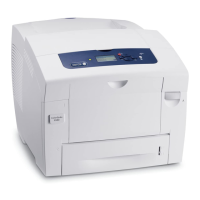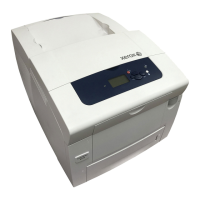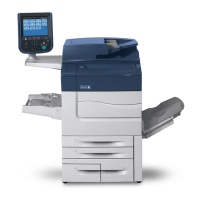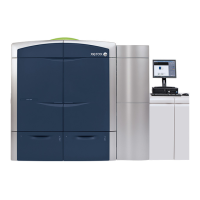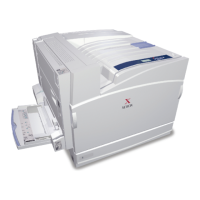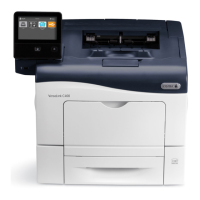October 2012
3-3
ColorQube 8570/8870 Service Manual
Print-Quality Problems Overview
Image Quality
Xerox Internal Use Only - Revised, 3rd Revision
Print-Quality Problems Overview
Print-quality defects can be attributed to printer components, consumables, media, internal
software, external software applications, and environmental conditions. To successfully trou
-
bleshoot print-quality problems, as many variables as possible must be eliminated. The first
step to generate prints using printable pages embedded in the printer on paper from the Rec
-
ommended Media List (RML). Print the Paper Tips Page for a list of supported media. The
paper should be from an unopened ream that has been acclimated to room temperature.
Print-Quality Defect Definitions and Procedure
After determining the source of the image quality problem, examine the image and select the
relevant corrective procedure from Table 1.
Table 2 provides definitions of various defects that are not referenced in IQ1 - IQ22 RAPs.
Table 1 Print-Quality Definitions
RAP Defect Description
IQ1 Image Quality Entry RAP General RAP information.
IQ2 Random Light Stripes There is one or more color bars are missing on
the page.
IQ3 Predominant Light Stripes,
Scratches or Marks Down the
Print or Parallel to the Long Axis
of Printing
Color bars of all 4 colors are missing on the page.
IQ4 Streaks, Smudges, or Smears
Down the Print
Ink displaced in the process direction. Variation in
gloss seen as a line in the process direction.
IQ5 Partial Image/ Color Missing All of the image does not transfer to the paper.
IQ6 The Printed Image is too Light or
Dark
The overall image density is too light or too dark.
IQ7 No Image is Printed The entire image area is blank.
IQ8 Color is Uneven or Wrong (Uni-
formity)
How dark or light a single color appears in multiple
areas.
IQ9 Skew The printed image is not parallel with both sides of
the paper.
IQ10 Ink on White Portion of the
Printed Page
Color on a print where no color should be printed is
often called a latent image.
IQ11 Fuzzy or Blurry Printing The image or text appears blurry on the page.
IQ12 Vertical Lines Appear Wavy The printed image has wavy column line in the
direction of the paper travel.
IQ13 Ghosting Latent image
IQ14 Oil on Print Oil stains the edge of the print.
IQ15 Incomplete Image Transfer,
Drop Out, Loss of Image Pixels
Portion of image is not transferred from the Drum to
page.
IQ16 Repeating Print Defects Image defect occurring at regular intervals.
IQ17 White Stripes (Pinstripes) This print-quality problem has a series of regularly
spaced white stripes approximately 0.7 mm (0.03
in.) apart.
IQ18 Media Wrinkling or Damage Areas of prints have distinctive "worm track" pat-
terns, and/or wrinkles in the paper itself
IQ19 Image is Offset or Cutoff Image is not centered on the page.
IQ20 Poor Ink Adhesion, Poor Image
Durability
The overall image density is too light in all colors.
IQ21 Gloss Irregularities Variations in the glossiness of the printed image.
IQ22 Grainy Speckled or sand-like appearance in what is meant
to be a smooth area.
Table 2 General Print-Quality Definitions
Defect Description
Banding Image irregularities in the cross process direction.
Blocking Ink transfer from an adjacent print in the stack.
Cohesion Image transfer to media (transfix quality).
Contamination Ink or other debris easily wiped from image or component.
Damage The media is cut, wrinkled, or folded.
Freckles Pixels not removed from the drum deposited on later prints.
Ink Discoloration Color shift due to the ink remaining molten but unused in the
delivery path for long periods of time or different ink colors
mixing.
Intensity How dark or light a color appears (saturation).
Offset Ink deposited on incorrect area of print.
Pixel Single image pixel of ink.
Process Defect Media or image irregularity from media transport.
Roller Mark Variation in gloss seen as a line in the process direction.
Spot One or more random spots transfixed to the media.
Stripper Blade Marks Line in the cross process direction from the stripper blade.
Void Area of image without ink.
Table 1 Print-Quality Definitions
RAP Defect Description

